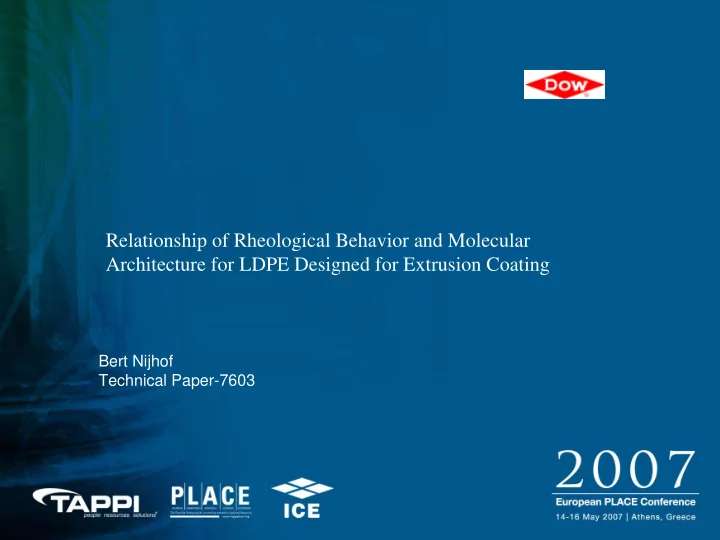

Relationship of Rheological Behavior and Molecular Architecture for LDPE Designed for Extrusion Coating Bert Nijhof Technical Paper-7603
Introduction • LDPE produced commercially for first time in 1939 • Process – Radical polymerization (initiated by oxygen/peroxides) – Conditions: 1000–3000 bar / 80–300 o C – Autoclave or Tubular process (or combination) • Product – Branched with varying branch length: • Copolymerization with e.g. propylene (short) • Intra molecular H transfer (short) • Inter molecular H transfer (short - long) • Long chain branches (LCB) dominate flow of the LDPE melt • Transition from short to long chain branch at a critical molecular weight, M e (entanglement molecular weight) • Transition in rheology behavior at M e . Paper 7603 - Bert Nijhof
Macromolecules • Long flexible chain of N repeating monomer units of molecular weight m 0 ∆ H – Ethylene (C 2 H 4 ) polyethylene H-(C 2 H 4 )N-H = ⋅ M N m 0 • Real polymers are mixtures of chains with different weight M . Distribution of M, with moments, M n , M w etc.. ∑ = ⋅ k M n M n M k M M M Paper 7603 - Bert Nijhof
Macromolecules • Molecule with molecular weight M is ‘coil’ in 3D space. • Characterized by a radius of gyration ( R g ) ∝ 1 D R M g or ( ) ρ ∝ − − ∝ − − ( 3 D ) 3 D 1 D - fractal dimension R M s g ρ s – molecular density single coil in solvent/melt • For linear polymers independent of M or polymer type – D =1.7 in good solvent (Flory) – D =2 in the melt (ideal chain) • Density determines overlap between molecules in the melt. • Melt viscosity for M>M e (Mark-Houwink) η ∝ ∝ ρ − 3 . 4 6 . 8 Zero shear viscosity M 0 s Paper 7603 - Bert Nijhof
MWD plot (example) Autoclave Tubular 1 Mn (M 1 ) 11182 13313 Mw (M 2 ) 119477 100138 0.8 Mz (M 3 ) 510364 360125 Autoclave (dwt/dlogM) Tubular D (M 2 /M 1 ) 10.68 7.52 0.6 0.4 0.2 0 2 3 4 5 6 7 Molecular Weight, log(M) Paper 7603 - Bert Nijhof
Effect of branching 2.2 Tubular 2 Autoclave Radiius of Gyration, log(R g ) Linear (HDPE) D = 1.7 model 1.8 Linear (model) 1.6 1.4 y = 0.5784x - 1.5811 1.2 R 2 = 0.9991 1 3 4 5 6 7 Molecular weight, log(M) Conformation plot obtained from Gel Permeation Chromatography (GPC) with Multiple Angle Laser Light Scattering (MALLS) detector (GPC-MALLS). Paper 7603 - Bert Nijhof
LDPE melt viscosity 5.0 Tubular Zero shear viscosity, log( η 0 ) [Pa.s] Autoclave Linear (Linear MH) 4.5 4.0 3.5 3.0 4.75 4.95 5.15 Molecular weight, log(M w ) [g.mol -1 ] Plot obtained from Oscillatory shear rheometry (OSR) Temperature 170 o C Paper 7603 - Bert Nijhof
Effects of branching • Branching reduces swell of polymer – For same M lower R g i.e. denser molecule – Less overlap for same M , viscosity decreases. Mark Houwink no longer valid, especially for autoclave products. – Transition observed in exponent D at a critical molecular weight M=M ξ Exponent D D L (M<M ξ ) D H (M>M ξ ) Autoclave (1.7-2) 3 Tubular (1.7-2.5) Various Paper 7603 - Bert Nijhof
Density plot (example) 10 y = 69x -1.00 ρ 1 ρ 2 density ( ρ s ) 1 10 100 HDPE ref y = 126x -1.27 Autoclave Tubular LLDPE ξ 2 ξ 1 0.1 Radius of gyration (R g ) ξ − Correlation length Density plot obtained from GPC-MALLS Paper 7603 - Bert Nijhof
Summary – Transition marks change from SCB => LCB – Critical molecular weight M ξ related to entanglement molecular weight, M e – Intra molecular entanglements affect swell behavior – Autoclave products (CSTR): • single variable scaling ( ξ ) – Tubular products (PFR with axial dispersion): • multivariable scaling (cascade of CSTR’s) or • Approximate scaling Paper 7603 - Bert Nijhof
Critical conditions LCB ⇔ 1200 SCB Critical molecular weight, M ξ 1000 800 600 y = 2799.6x -1.1363 400 R 2 = 0.678 200 1< exponent < 1.3 (Graessley) 0 0.0 1.0 2.0 3.0 4.0 5.0 6.0 7.0 ρ ξ Critical density, Plot obtained from GPC-MALLS Paper 7603 - Bert Nijhof
Autoclave products ⎛ ⎞ R ρ ∝ − α ⋅ ⎜ ⎟ g R F ⎜ ⎟ ξ β s g ⎝ ⎠ 10 2ξ Density, ρ s < ξ > ξ R R g g − α β ρ ∝ ρ ∝ ξ R s g s ξ 1 10 100 R g Rheology of autoclave products depends on: ξ (or M ξ / ρ ξ ) and (depending on conditions and sample set) on one or more of the moments M k . Paper 7603 - Bert Nijhof
Melt Index 1 1.2 Tubular 1 Autoclave Melt index, log( I 2 ) [dg.min -1 ] Mixture 0.8 0.6 0.4 0.2 0 -0.2 -0.4 5.40 5.60 5.80 6.00 6.20 Cross-over Molecular weight, log(M ξ ) [g.mol -1 ] Paper 7603 - Bert Nijhof
Melt Index 2 1.2 1 Tubular Melt index, log( I 2 ) [dg.min -1 ] Autoclave 0.8 Mixture 0.6 0.4 0.2 0 -0.2 -0.4 4.50 5.00 5.50 Weight average molecular weight, log(M w ) [g.mol -1 ] Paper 7603 - Bert Nijhof
Application example: Neck-in 300 320/100 α β − = ⋅ ⋅ 320/300 Neck in a M M 250 ξ 0 z Neck-in predicted [mm] 290/100 290/300 all 200 Linear (all) MODEL Stdev NI y = 0.9975x R 2 = 0.9893 150 M z /M ξ 4.1 M w /M ξ 7.8 100 M z 6.9 M w 12.7 50 50 100 150 200 250 300 Neck-in observed [mm] Measured on Pilot Coater at different Temperature( o C) /Linespeed(m/min) and 12 g/m 2 Paper 7603 - Bert Nijhof
Recommend
More recommend